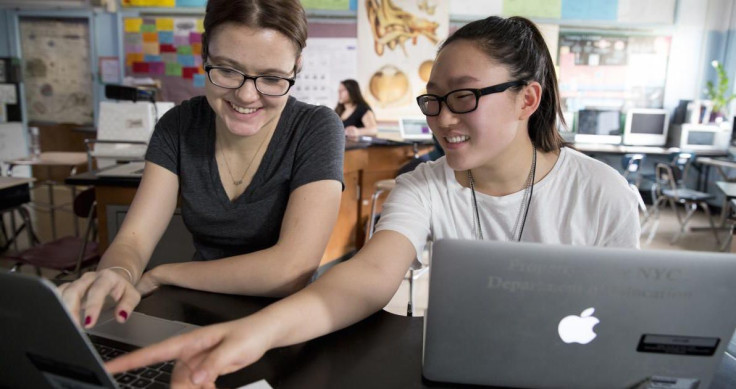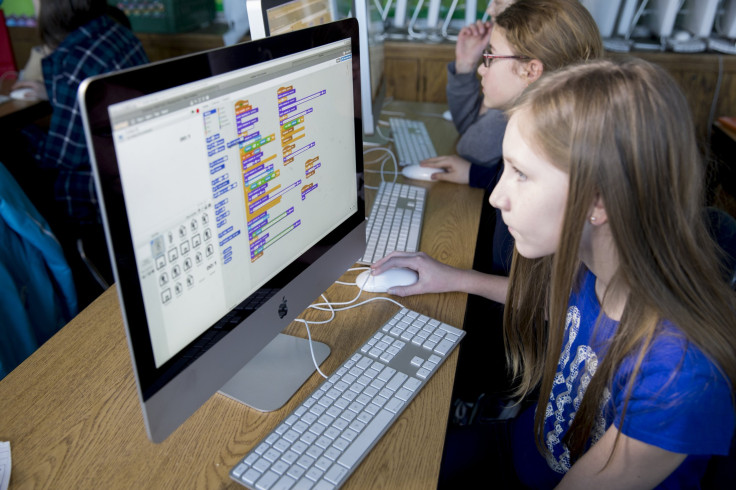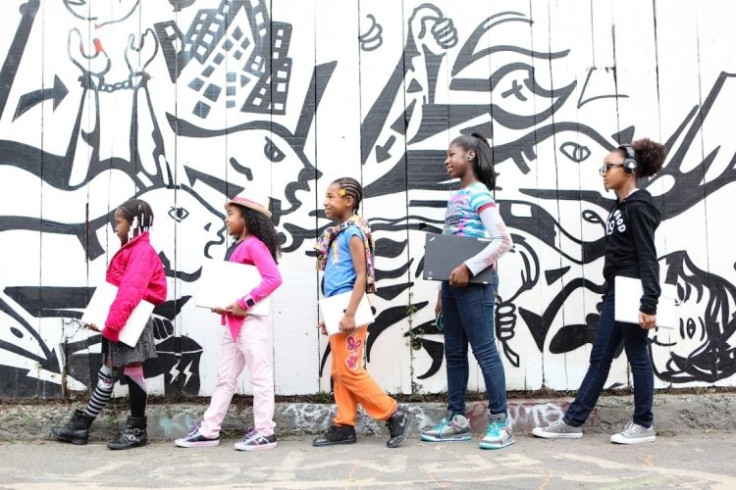Taking Back Computer Science: Young Girls Who Learn Code Acquire Problem Solving Skills, Feel Empowered

I learned to code by accident.
A happy accident, yes, but not what I intended when I declared professional writing as my college major. What my professors taught me in the few design classes I took helped me land an internship with an online publication hosted by Drupal, a leading content management system (CMS). My experience with this particular CMS afforded me a separate opportunity with a team working to relaunch its global website. All of this combined to get me in a position producing content for a major magazine, which included making newsletter templates from scratch. I still remember a graphic designer I dated telling me his jaw dropped after hearing this same story.
Because while Sheryl Sandberg is leaning in at Facebook, Mark Zuckerberg is who most people name when talking about computer code. In fact, men in general are the face of computer code and science. Think of the late and great Steve Jobs or Bill Gates. One study published in the journal Science actually surveyed more than 1,800 graduate students, post-doctoral researchers, and faculty members across 30 academic disciplines and found women were severely underrepresented in the science, technology, engineering, and mathematics fields. Why? Researchers suggested the pressure to be brilliant in these fields turns women away. Yet, plenty of men rise to the occasion. Do you see where I’m going with this?
Reshma Saujani, founder and CEO of the non-profit organization Girls Who Code (GWC), did. Her idea for the organization came to her after running for congress in a poorer district of New York in 2010. In the same afternoon that she'd meet kids with every gadget imaginable, she’d also meet kids with no access to a computer or a teacher to show them to use what was available. Seeing firsthand how stark the gender divide in tech really is, she knew she needed to start a program that would teach girls to code.
“I became convinced, and am even more convinced every day, that teaching girls to code is the domestic issue of our time,” Saujani told Medical Daily in an email. She added that GWC’s main purpose is to empower young girls to build the technology they want to see in the world, as well as assure them coding isn’t only for “geeky guys locked in a dark basement.” It’s for anyone from the prom queen to the bookworms.
“Today, women are more than half our workforce but hold just 25 percent of the jobs in computing and technical fields, and that divide is only going to get bigger if we don’t do something about it,” Saujani said. “With more and more jobs being created in the computer fields — 1.4 million of them by 2020 — leaving our girls behind just can’t be an option.”
It seems Google is on the same page as Saujani. USA Today reported this week that the tech giant is partnering with Boys & Girls Clubs of America to introduce a program called CS First to more elementary and middle school students across the country. The program is designed to teach, “kids ages 9 to 14 how to express themselves and their interests through computer code.” In New York, the NY Daily News added all kids enrolled in 857 after-school programs across all five boroughs will get to use CS First as part of the $10 million Tech Talent Pipeline initiative Mayor Bill de Blasio launched last May.

Dialing Into Success
CS First essentially functions as a free computer club. It provides young girls (and boys) access to computer science materials, which for some students is more than they could have imagined.
“We have girls who are coming from tough circumstances. Either they have a parent who has just been laid off or they’re living in several generations of public housing,” Saujani said. “GWC gives them an opportunity to be eligible for the best jobs in the country, when perhaps college wasn’t even in their set of possibilities previously.”
UNICEF cites that "early childhood, which spans the period up to 8 years of age, is critical for cognitive, social, emotional, and physical development." This is especially applies to low-income students. According to the latest survey from the National Center for Children in Poverty, poverty affects 30 percent of children living in the U.S. The center reported these effects are profound, impacting a child's ability to learn and exacerbating "behavioral, social, and emotional problems as well, not due to the lack of income, but because of the instability associated with fluctuating incomes."
When researchers from the University of California, Los Angeles placed low-income students in higher quality schools, they found students engaged less in risky behaviors, including binge drinking, drug use, carrying a weapon to school, and gang membership. Additionally, these students spent more time studying. While not only low-income students are presented with these computer science opportunities, the research shows how important it is to have access to programs that can promote learning.
Basic coding in particular, Edutopia cited, has been shown to increase problem solving skills. "Being able to follow programming logic trains the mind to think more analytically." Seymour Papert, an MIT mathematician and computer scientist, says that "computer's true power as an educational medium lies in the ability to facilitate and extend children's awesome natural ability and drive to construct, hypothesize, explore, experiment, evaluate, and draw conclusions." Some experts have even said computer code is "the new literacy."
Mitch Resnik, a computer scientist at MIT's Media Lab, is one of those experts. Resnik is responsible for another free coding program called Scratch, where kids can create their own interactive stories, games, and animations. In his 2012 TED Talk, Resnick said children can use programs like Scratch to code and interact with the physical world around them.
“When you learn to read and write, it opens up opportunities for you to learn so many other things. When you learn to read, you can then read to learn. And it's the same thing with coding,” he said. “If you learn to code, you can code to learn. Now some of the things you can learn are sort of obvious. You learn more about how computers work. But that's just where it starts. When you learn to code, it opens up for you to learn many other things.”
In addition to the skills Papert outlined, Resnick added young children who learn to code also learn the processes of design; they learn how to collaborate with others; and more importantly, they learn to keep persistent and persevere in the face of frustrations when things aren't working well. You’ll notice these skills extend far beyond the computer.

Girl Code
If you’ve come across a little game called Tampon Run, you’ll know its creators, Sophie, 16, and Andy, 17, are GWC alums. Sophie jokingly proposed the idea after Andy said she wanted to create a video game about the hypersexualization of women in other video games. When they were doing their research, the girls realized menstrual taboo was a larger, more global issue than they realized. So they went through with the idea, using humor to promote a thoughtful discussion.
“I loved the process of creating the game,” Sophie told Medical Daily in an e-mail. “The screen went from being blank, to having a background, to having colored blocks, to sprites that jumped and threw. I knew how each new feature worked down [to] the code and I knew that something I had programmed was making it all happen. That was empowering.”
Sophie didn’t know much about coding before her mother encouraged her to apply to GWC. Andy, on the other hand, would read novels with “teen gangs” that would save the world; each group had someone whose purpose was to hack into security systems and programs — she wanted to be that person. GWC was the first environment in which she didn’t feel intimidated by her passion for code.
“When I went to my first coding camp (SummerTech Computer Camps), I went there entirely by myself. None of my friends were there, and there were so many guys,” Andy said. “People are surprised when they hear that I’m into computer science, but I think I’m very lucky to have grown up in a community where everyone has been supportive of my endeavors.”
Both Sophie and Andy were astonished to see their game go viral. They receive fan mail from people all over the world, and the user feedback they received was incorporated into their mobile version of the game, which launched in the iTunes app store earlier this month. Saujani’s husband, Nihal Mehta, connected the girls to Pivotal Labs, a leading development firm, who offered their services to the girls pro bono.
“They wanted to support us as young women entering the tech field because they believe in making the tech community more diverse,” Sophie said. “Andy and I went there everyday after school to pair with the developers, which means we got to hone our coding skills and see how real programmers work.”
While the girls certainly honed their coding skills and had the opportunity to gain real-life experience, not to mention create a wildly successful video game, they each said GWC helped them to improve their public speaking. What’s more is each girl feels like they can better advocate for themselves. They both made new friends, too.
“I got to know girls who were so different than me,” Sophie said. “I got to fail with them and succeed with them, and by the end of the summer, I felt much more connected to and proud of my womanhood.”
For Saujani, this sisterhood has been the most rewarding experience of GWC (if she absolutely had to pick, of course). This connection will enable girls, like Sophie and Andy, to succeed as they continue in their paths in computer science.
GWC, Google, de Blasio, and Resnick aren't the only ones working to take back computer science. Black Girls Who Code, CodeNow, and Codeacademy are also working to make computer code accessible to any and everyone, as it should be.



























